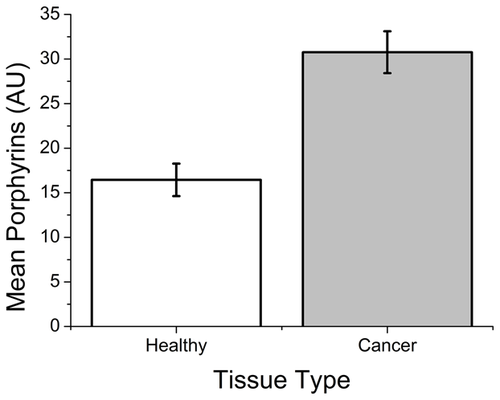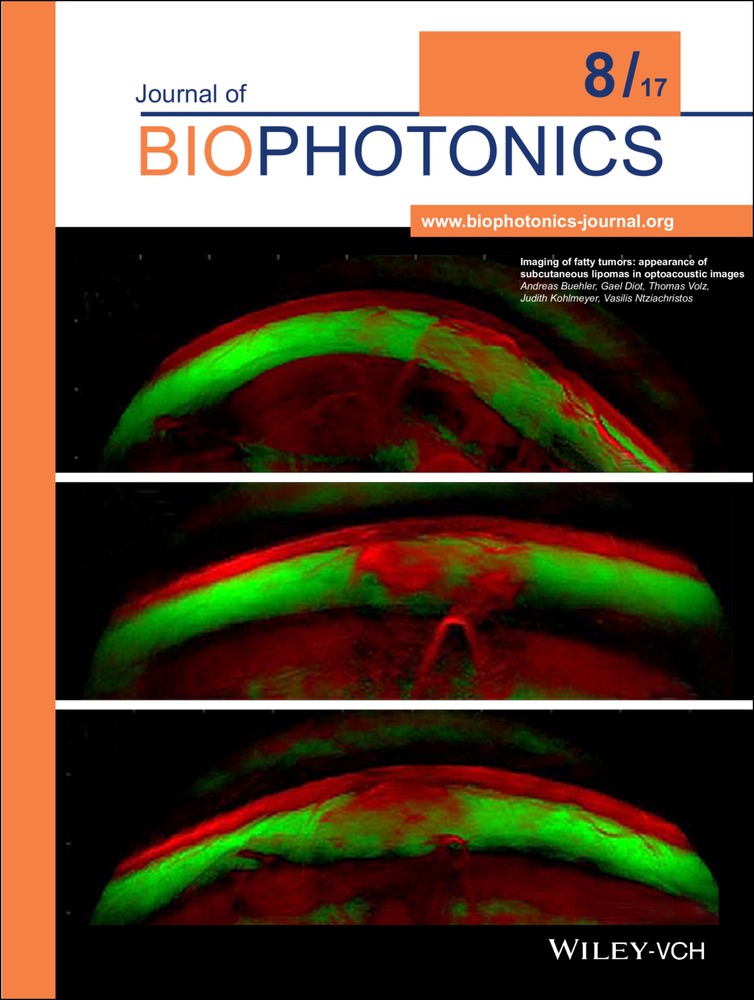Optical redox ratio and endogenous porphyrins in the detection of urinary bladder cancer: A patient biopsy analysis
Scott Palmer
Division of Imaging and Technology, University of Dundee, Ninewells Hospital and Medical School, James Arrott Drive, Dundee, UK DD1 9SY
Search for more papers by this authorKarina Litvinova
Optoelectronics and Biomedical Photonics Group, Aston Institute of Photonic Technologies, Aston University, Aston Triangle, Birmingham, UK B4 7ET
Search for more papers by this authorAndrey Dunaev
Biomedical Photonics Instrumentation Group, Scientific-Educational Centre of “Biomedical Engineering”, Orel State University, Orel, Russia, 302020
Search for more papers by this authorJi Yubo
Division of Imaging and Technology, University of Dundee, Ninewells Hospital and Medical School, James Arrott Drive, Dundee, UK DD1 9SY
Search for more papers by this authorDavid McGloin
SUPA, School of Science and Engineering, Ewing Building, University of Dundee, Nethergate, Dundee, UK DD1 4HN
Search for more papers by this authorCorresponding Author
Ghulam Nabi
- [email protected]
- (+44) 01382 660111
Division of Imaging and Technology, University of Dundee, Ninewells Hospital and Medical School, James Arrott Drive, Dundee, UK DD1 9SY
Corresponding author: e-mail: [email protected], Phone: (+44) 01382 660111
Search for more papers by this authorScott Palmer
Division of Imaging and Technology, University of Dundee, Ninewells Hospital and Medical School, James Arrott Drive, Dundee, UK DD1 9SY
Search for more papers by this authorKarina Litvinova
Optoelectronics and Biomedical Photonics Group, Aston Institute of Photonic Technologies, Aston University, Aston Triangle, Birmingham, UK B4 7ET
Search for more papers by this authorAndrey Dunaev
Biomedical Photonics Instrumentation Group, Scientific-Educational Centre of “Biomedical Engineering”, Orel State University, Orel, Russia, 302020
Search for more papers by this authorJi Yubo
Division of Imaging and Technology, University of Dundee, Ninewells Hospital and Medical School, James Arrott Drive, Dundee, UK DD1 9SY
Search for more papers by this authorDavid McGloin
SUPA, School of Science and Engineering, Ewing Building, University of Dundee, Nethergate, Dundee, UK DD1 4HN
Search for more papers by this authorCorresponding Author
Ghulam Nabi
- [email protected]
- (+44) 01382 660111
Division of Imaging and Technology, University of Dundee, Ninewells Hospital and Medical School, James Arrott Drive, Dundee, UK DD1 9SY
Corresponding author: e-mail: [email protected], Phone: (+44) 01382 660111
Search for more papers by this authorAbstract
Bladder cancer is among the most common cancers in the UK and conventional detection techniques suffer from low sensitivity, low specificity, or both. Recent attempts to address the disparity have led to progress in the field of autofluorescence as a means to diagnose the disease with high efficiency, however there is still a lot not known about autofluorescence profiles in the disease. The multi-functional diagnostic system “LAKK-M” was used to assess autofluorescence profiles of healthy and cancerous bladder tissue to identify novel biomarkers of the disease. Statistically significant differences were observed in the optical redox ratio (a measure of tissue metabolic activity), the amplitude of endogenous porphyrins and the NADH/porphyrin ratio between tissue types. These findings could advance understanding of bladder cancer and aid in the development of new techniques for detection and surveillance.
Supporting Information
| Filename | Description |
|---|---|
| jbio201600162-sup-0001-author-biographies.pdfPDF document, 548.4 KB | Author Biographies |
Please note: The publisher is not responsible for the content or functionality of any supporting information supplied by the authors. Any queries (other than missing content) should be directed to the corresponding author for the article.
References
- 1 CRUK, Bladder cancer statistics. 2016; http://www.cancerresearchuk.org/health-professional/cancer-statistics/statistics-by-cancer-type/bladder-cancer. Accessed 21.04.16, 2016.
- 2P. A. Humphrey, J. Urol. 187 (3), 1057–1058 (2012).
- 3P. S. Sullivan, J. B. Chan, M. R. Levin, and J. Rao, Am. J. Transl. Res. 2 (4), 412–440 (2010).
- 4R. Talwar, T. Sinha, S. C. Karan, D. Doddamani, A. Sandhu, G. S. Sethi, A. Srivastava, V. Narang, A. Agarwal, and N. Adhlakha, Urology 70 (2), 267–271 (2007).
- 5F. A. Yafi, F. Brimo, J. Steinberg, A. G. Aprikian, S. Tanquay, and W. Kassouf, Urol. Uncol. 33 (2), 25–31 (2015).
- 6B. L. Isfoss, BJU Int. 108 (11), 1703–1707 (2011).
- 7G. Mowatt, J. N'Dow, L. Vale, G. Nabi, C. Boachie, J. A. Cook, C. Fraser, and T. R. Griffiths, Aberdeen Technology Assessment Review (TAR) Group, Int. J. Technol. Assess. Health Care 27 (1), 3–10 (2011).
- 8H. Ren, K. C. Park, R. Pan, W. C. Waltzer, K. R. Shroyer, and Y. Pan, J. Urol. 187 (3), 1063–1070 (2012).
- 9D. J. Parekh, B. H. Bochner, and G. Dalbagni, J. Clin. Oncol. 24 (35), 5519–5527 (2006).
- 10H. Maeda, Adv. Enzyme Regul. 41, 189–207 (2001).
- 11J. E. Frampton and G. L. Plosker, Drugs 66 (4), 571–578 (2006).
- 12K. Inoue, U. Ota, M. Ishizuka, C. Kawada, H. Fukuhara, T. Shuin, I. Okura, T. Tanaka, and S. Ogura, Photodiagnosis Photodyn. Ther. 10 (4), 484–489 (2013).
- 13M. Burger, H. B. Grossman, M. Droller, J. Schmidbauer, G. Hermann, O. Dragoescu, E. Ray, Y. Fradet, A. Karl, J. P. Burgues, J. A. Witjes, A. Stenzl, P. Jichlinski, and D. Jocham, Eur. Urol. 64 (5), 846–854 (2013).
- 14A. Stenzl, M. Burger, Y. Fradet, L. A. Mynderse, M. S. Soloway, J. A. Witjes, M. Kriegmair, A. Karl, Y. Shen, and H. B. Grossman, J. Urol. 184 (5), 1907–1913 (2010).
- 15M. C. Grimbergen, C. F. van Swol, T. G. Jonges, T. A. Boon, and R. J. van Moorselaar, Eur. Urol. 44 (1), 51–56 (2003).
- 16A. B. Ghisaidoobe and S. J. Chung, Int. J. Mol. Sci. 15 (12), 22518–22538 (2014).
- 17L. Zhang, Y. Pu, J. Xue, S. Pratavieira, B. Xu, S. Achilefu, and R. R. Alfano, J. Biomed. Opt. 19 (3), 37005 (2014).
- 18V. Prabhu, S. B. Rao, E. M. Fernandes, A. C. Rao, K. Prasad, and K. K. Mahato, PLoS One 9 (5), e98609 (2014).
- 19P. L. Tong, J. Qin, C. L. Cooper, P. M. Lowe, D. F. Murrell, S. Kossard, L. G. Ng, B. Roediger, W. Weninger, and N. K. Haass, Br. J. Dermatol. 169 (4), 869–879 (2013).
- 20K. Drozdowicz-Tomsia, A. G. Anwer, M. A. Cahill, K. N. Madlum, A. M. Maki, M. S. Baker, and E. M. Goldys, J. Biomed. Opt. 19 (8), 086019 (2014).
- 21J. Horilova, B. Cunderlikova, and A. Marcek Chorvatova, J. Biomed. Opt. 20 (5), 51017 (2015).
- 22L. C. Courrol, F. R. de Oliveira Silva, E. L. Coutinho, M. F. Piccoli, R. D. Mansano, N. D. Vieira Jr., N. Schor, and M. H. Bellini, J. Fluoresc. 17 (3), 289–292 (2007).
- 23H. Sato and T. Takino, Cancer Sci. 101 (4), 843–847 (2010).
- 24M. G. Vander Heiden, L. C. Cantley, and C. B. Thompson, Science 324 (5930), 1029–1033 (2009).
- 25A. Varone, J. Xylas, K. P. Quinn, D. Pouli, G. Sridharan, M. E. McLaughlin-Drubin, C. Alonzo, K. Lee, K. Munger, and I. Georgakoudi, Cancer Res. 74 (11), 3067–3075 (2014).
- 26Q. Liu, G. Grant, J. Li, Y. Zhang, F. Hu, S. Li, C. Wilson, K. Chen, D. Bigner, and T. Vo-Dinh, J. Biomed. Opt. 16 (3), 037004 (2011).
- 27J. H. Ostrander, C. M. McMahon, S. Lem, S. R. Millon, J. Q. Brown, V. L. Seewaldt, and N. Ramanujam, Cancer Res. 70 (11), 4759–4766 (2010).
- 28S. Palmer, K. Litvinova, E. U. Rafailov, and G. Nabi, Biomed. Opt. Express 6 (3), 977–986 (2015).
- 29R. R. Alfano, B. B. Das, J. Cleary, R. Prudente, and E. J. Celmer, Bull N Y Acad. Med. 67 (2), 143–150 (1991).
- 30R. R. Alfano, D. Tata, J. Cordero, P. Tomashefsky, F. Londo, and M. Alfano, IEEE J. Quant. Electr. 20, 1507–1511 (1984).
- 31N. Ramanujam, Neoplasia 2 (1–2), 89–117 (2000).
- 32M. A. D'Hallewin, L. Baert, and H. Vanherzeele, J. Am. Paraplegia Soc. 17 (4), 161–164 (1994).
- 33W. Zheng, W. Lau, C. Cheng, K. C. Soo, and M. Olivo, Int. J. Cancer 104 (4), 477–481 (2003).
- 34C. Schafauer, D. Ettori, M. Roupret, V. Phe, J. M. Tualle, E. Tinet, S. Avrillier, C. Egrot, O. Traxer, and O. Cussenot, J. Urol. 190 (1), 271–277 (2013).
- 35O. Aboumarzouk, R. Valentine, R. Buist, S. Ahmad, G. Nabi, S. Eljamel, H. Moseley, and S. G. Kata, Photodiagnosis Photodyn. Ther. 12 (1), 76–83 (2015).
- 36I. Rokahr, S. Andersson-Engels, S. Svanberg, M. D'Hallewin, L. Baert, I. Wang-Nordman, and K. Svanberg, Proc. SPIE 2627, 2 (1995).
- 37M. A. D'Hallewin, L. Bezdetnaya, and F. Guillemin, Eur. Urol. 42, 417–425 (2002).
- 38Y. Pu, W. Wang, G. Tang, and R. R. Alfano, J. Biomed. Opt. 15 (4), 047008 (2010).
- 39I. Georgakoudi, B. C. Jacobson, M. G. Muller, E. E. Sheets, K. Badizadegan, D. L. Carr-Locke, C. P. Crum, C. W. Boone, R. R. Dasari, J. Van Dam, and M. S. Feld, Cancer Res. 62 (3), 682–687 (2002).
- 40R. Drezek, K. Sokolov, U. Utzinger, I. Boiko, A. Malpica, M. Follen, and R. Richards-Kortum, J. Biomed. Opt. 6 (4), 385–396 (2001).
- 41M. Anidjar, O. Cussenot, S. Avrillier, D. Ettori, J. M. Villette, J. Fiet, P. Teillac, and A. Le Duc, J. Biomed. Opt. 1 (3), 335–341 (1996).
- 42S. Palmer, K. Litvinova, A. Dunaev, S. Fleming, D. McGloin, and G. Nabi, Biomed. Opt. Express 7 (4), 1193–1200 (2016).
- 43L. Shi, A. Rodriguez-Contreras, Y. Budansky, Y. Pu, T. A. Nguyen, and R. R. Alfano, J. Biomed. Opt. 19 (6), 066009 (2014).
- 44M. Inaguma and
K. Hashimoto,
Cancer
86
(11),
2201–2211
(1999).
10.1002/(SICI)1097-0142(19991201)86:11<2201::AID-CNCR5>3.0.CO;2-9 CAS PubMed Web of Science® Google Scholar
- 45M. H. Bellini, E. L. Coutinho, L. C. Courrol, F. Rodrigues de Oliveira Silva, N. D. Vieira Jr., and N. Schor, J. Fluoresc. 18 (6), 1163–1168 (2008).
- 46A. V. Dunaev, V. V. Dremin, E. A. Zherebtsov, I. E. Rafailov, K. S. Litvinova, S. G. Palmer, N. A. Stewart, S. G. Sokolovski, and E. U. Rafailov, Med. Eng. Phys. 37 (6), 574–583 (2015).
- 47N. Akbar, S. Sokolovski, A. Dunaev, J. J. Belch, E. Rafailov, and F. Khan, J. Microsc. 255 (1), 42–48 (2014).
- 48O. D. Smirnova, D. A. Rogatkin, and K. S. Litvinova, J. Innov. Opt. Health Sci. 5 (2), 1–9 (2012).
- 49K. S. Litvinova, D. A. Rogatkin, O. A. Bychenkov, and V. I. Shumskiy, Proc. SPIE 7547, Saratov fall meeting (2009).
- 50A. C. Croce and G. Bottiroli, Eur. J. Histochem. 58 (4), 2461 (2014).
- 51A. Mayevsky and B. Chance, Mitochondrion 7 (5), 330–339 (2007).
- 52H. Zeng, C. MacAulay, D. I. McLean, B. Palcic, and H. Lui, Photochem. Photobiol. 68 (2), 227–236 (1998).
- 53L. M. Tiede and M. G. Nichols, Photochem. Photobiol. 82 (3), 656–664 (2006).
- 54A. Mayevsky and G. G. Rogatsky, Am. J. Physiol. Cell Physiol. 292 (2), 615–640 (2007).
- 55A. J. Walsh, K. M. Poole, C. L. Duvall, and M. C. Skala, J. Biomed. Opt. 17 (11), 116015 (2012).
- 56K. Koenig and H. Schneckenburger, J. Fluoresc. 4 (1), 17–40 (1994).
- 57I. Freitas, E. Boncompagni, R. Vaccarone, C. Fenoglio, S. Barni, and G. F. Baronzio, Anticancer Res. 27 (5A), 3059–3065 (2007).
- 58D. M. Harris and J. Werkhaven, Lasers Surg. Med. 7 (6), 467–472 (1987).
- 59S. N. Datta, C. S. Loh, A. J. MacRobert, S. D. Whatley, and P. N. Matthews, Br. J. Cancer 78 (8), 1113–1118 (1998).
- 60F. Koenig, F. J. McGovern, A. F. Althausen, T. F. Deutsch, and K. T. Schomacker, J. Urol. 156 (5), 1597–1601 (1996).
- 61I. Rafailov, S. Palmer, K. Litvinova, V. Dremin, A. Dunaev, and G. Nabi, Proceedings SPIE, San Francisco, USA, 2015, Photonic Therapeutics and Diagnostics XI, 93030W (2015).
- 62I. E. Rafailov, V. V. Dremin, K. S. Litvinova, A. V. Dunaev, S. G. Sokolovski, and E. U. Rafailov, J. Biomed. Opt. 21 (2), 25006 (2016).
- 63A. V. Dunaev, V. V. Sidorov, A. I. Krupatkin, I. E. Rafailov, S. G. Palmer, N. A. Stewart, S. G. Sokolovski, and E. U. Rafailov, Physiol. Meas. 35 (4), 607–621 (2014).
- 64P. Irwin and N. T. Galloway, J. Urol. 149 (4), 890–892 (1993).
- 65W. R. Wilson and M. P. Hay, Nat. Rev. Cancer 11 (6), 393–410 (2011).





